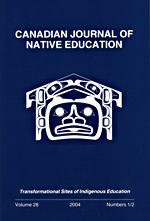 Transformational
Sites of Indigenous Education
Transformational
Sites of Indigenous Education
CANADIAN JOURNAL OF NATIVE EDUCATION
Volume 28, 2004, Numbers 1/2
The Forests and Oceans for the Future papers in Vol. 28 (#1 & 2) of the Canadian Journal of Native Education are one of the outcomes of a unique collaboration between anthropological researchers from UBC and community members from Gitxaała. From conception through implementation, revision, and reporting back to the whole community, collaboration and respectful research practices were placed as the central and fundamental principle of work. As described in the papers by Lewis, Menzies, and McDonald, implementing this approach was not a simple or straightforward application of rules of conduct, but rather was built upon a conception of research as a long term relationship. As with all such relationships this process required goodwill, commitment, and compromise.
CONTENTS
1. Forests for the Future: The View from
Gitkxaała. Wuyee Wi Medeek (John Lewis)
Wuyee Wi Medeek (John Lewis) speaks from his vantage point
as Gitxaała’s Chief Treaty Negotiator. Wuyee Wi Medeek opens our volume
with a reflection on the benefits of collaborative research, the difficulties
inherent in such an operation, the community experience of the Forests for
the Future project, and a consideration of areas that could be improved for
future research projects. His contribution provided the inspiration for the
accompanying video, The View from Gitxaała, which documents the research
process used.
2.Putting Words into Action: Negotiating Collaborative Research in Gitxaała.
Charles R. Menzies.
Menzies writes about the process of negotiating respectful research relationships.
This paper describes the actual process of consultation, accommodation, and negotiation
important in establishing and growing a respectful research relationship between the University and Gitxaała.
3. Researching Traditional Ecological Knowledge Knowledge for Multiple Uses. Caroline
Butler.
Caroline Butler writes from the perspective of a field researcher charged with coordinating
the on the ground research in the community. In her paper she examines the ways in which the particular and
differing interests of researcher and community members can pull together to produce research results that
simultaneously meet the needs of communities and fulfil the expectations of research institutions.
4. Opening
Doors to the Future: Applying Local Knowledge in Curriculum Development. Veronica
Ignas.
Ignas’ paper lays out the underlying pedagogic and theoretical
frameworks that were used to guide the development of the Forests for the Future
Curriculum materials In her paper she describes the pedagogical and theoretical models
for curriculum design that informed the development of our curriculum materials.
5. Traditional
Plant Knowledge of the Tsimshian Curriculum: Keeping Knowledge in the Community.
Edosdi / Judith C. Thompson.
Edōsdi documents her experience as a Tahltan educator
in developing a Tsimshian plant knowledge lesson plan. Based upon her experience
working with the students and elders in Gitga’ata, Edōsdi reflects upon the
development of at Tsimshian plant knowledge lesson plan. Central to her discussion
is the importance of valuing local indigenous knowledge so that students “would
be able to view their own knowledge and the knowledge and wisdom of their
elders and community as both valid and valuable in the context of science,
and more generally, to all academic work.”
6. Educating
About Aboriginal Involvement with Forestry: The Tsimshian Experience—Yesterday,
Today and Tomorrow. Paul Orlowski and Charles Menzies.
Orlowski discusses the development and piloting experience
of the unit he designed for the project, Tsimshian Involvement in the Forest
Sector. Based upon earlier research his essay highlights the importance for
indigenous students of teaching materials that place the experience of their
community front and centre. Orlowski piloted the materials in two settings—within
the Tsimshian Territories and in a Vancouver school. While the responses were
different, Orlowski notes that materials that are relevant to students—i.e.,
Tsimshian materials for the north coast students and First Nations content
for the urban First Nations classes—is more likely to inspire and motivate
students and contribute to their success.
7. The Tsimshian Protocols: Locating and Empowering Community-based Research.
James Andrew McDonald.
James McDonald, an anthropologist who has worked with the
Tsimshian community of Kitsumkalum for nearly three decades, discuss the
importance of long term research relationships that respect the local—or in our
case Tsimshian- protocols. McDonald’s paper stands both as a summary of the
issues and contributions of this group of papers and as a significant contribution
on community-based research methodology in its own right. Anthropologists and
other social science researchers have often struggled with research ethics and
issues of power. McDonald’s paper demonstrates one important path out of this
quagmire: “to work with communities and individuals in ways that respect
their realities, their needs, and their futures.”